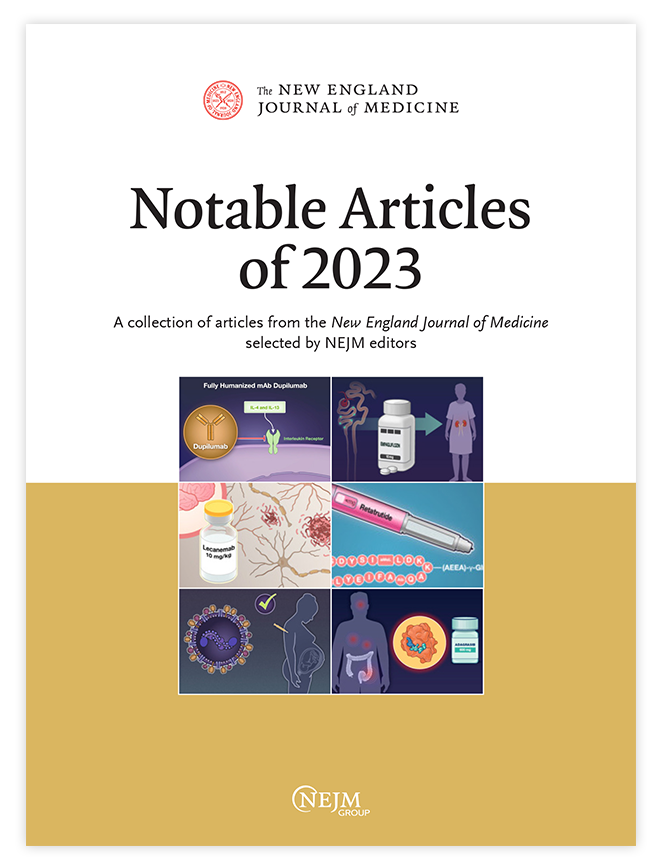Efficacy of Baloxavir Treatment in Preventing Transmission of Influenza.
IF 96.2
1区 医学
Q1 MEDICINE, GENERAL & INTERNAL
引用次数: 0
Abstract
BACKGROUND Baloxavir marboxil (baloxavir) rapidly reduces influenza virus shedding, which suggests that it may reduce transmission. Studies of treatment with neuraminidase inhibitors have not shown sufficient evidence that they prevent transmission to contacts. METHODS We conducted a multicountry, phase 3b trial to assess the efficacy of single-dose baloxavir treatment to reduce influenza transmission from index patients to household contacts. Influenza-positive index patients 5 to 64 years of age were randomly assigned in a 1:1 ratio to receive baloxavir or placebo within 48 hours after symptom onset. The primary end point was transmission of influenza virus from an index patient to a household contact by day 5. The first secondary end point was transmission of influenza virus by day 5 that resulted in symptoms. RESULTS Overall, 1457 index patients and 2681 household contacts were enrolled across the 2019-2024 influenza seasons; 726 index patients were assigned to the baloxavir group, and 731 to the placebo group. By day 5, transmission of laboratory-confirmed influenza was significantly lower with baloxavir than with placebo (adjusted incidence, 9.5% vs. 13.4%; adjusted odds ratio, 0.68; 95.38% confidence interval [CI], 0.50 to 0.93; P = 0.01), with an adjusted relative risk reduction of 29% (95.38% CI, 12 to 45). The adjusted incidence of transmission of influenza virus by day 5 that resulted in symptoms was 5.8% with baloxavir and 7.6% with placebo; however, the difference was not significant (adjusted odds ratio, 0.75; 95.38% CI, 0.50 to 1.12; P = 0.16). Emergence of drug-resistant viruses during the follow-up period occurred in 7.2% (95% CI, 4.1 to 11.6) of the index patients in the baloxavir group; no resistant viruses were detected in household contacts. No new safety signals were identified. CONCLUSIONS Treatment with a single oral dose of baloxavir led to a lower incidence of transmission of influenza virus to close contacts than placebo. (Funded by F. Hoffmann-La Roche and others; CENTERSTONE ClinicalTrials.gov number, NCT03969212.).巴洛昔韦治疗预防流感传播的疗效。
背景:baloxavir marboxil (baloxavir)可迅速减少流感病毒的脱落,这表明它可能减少传播。神经氨酸酶抑制剂治疗的研究没有显示出足够的证据表明它们可以防止传播给接触者。方法:我们开展了一项多国3b期试验,评估单剂量巴洛韦治疗减少流感从指数患者到家庭接触者传播的疗效。5至64岁的流感阳性指数患者在症状出现后48小时内按1:1的比例随机分配接受巴洛韦或安慰剂治疗。主要终点是流感病毒在第5天从指数患者传播到家庭接触者。第一个次要终点是流感病毒在第5天传播并导致症状。结果2019-2024年流感季节共纳入1457例指数患者和2681例家庭接触者;726例患者被分配到巴洛韦组,731例患者被分配到安慰剂组。到第5天,baloxavir的实验室确诊流感传播率明显低于安慰剂(调整后的发病率,9.5% vs. 13.4%;调整后优势比为0.68;95.38%可信区间[CI], 0.50 ~ 0.93;P = 0.01),调整后的相对风险降低29% (95.38% CI, 12 ~ 45)。巴洛昔韦组第5天流感病毒传播导致症状的调整发生率为5.8%,安慰剂组为7.6%;然而,差异不显著(校正优势比,0.75;95.38% CI, 0.50 ~ 1.12;p = 0.16)。在随访期间,巴洛韦组指数患者中出现耐药病毒的比例为7.2% (95% CI, 4.1 ~ 11.6);在家庭接触者中未发现耐药病毒。没有发现新的安全信号。结论单剂量口服巴洛韦治疗可使流感病毒传播给密切接触者的发生率低于安慰剂。(F. Hoffmann-La Roche等资助;CENTERSTONE ClinicalTrials.gov号码:NCT03969212)。
本文章由计算机程序翻译,如有差异,请以英文原文为准。
求助全文
约1分钟内获得全文
求助全文
来源期刊

New England Journal of Medicine
医学-医学:内科
CiteScore
145.40
自引率
0.60%
发文量
1839
审稿时长
1 months
期刊介绍:
The New England Journal of Medicine (NEJM) stands as the foremost medical journal and website worldwide. With an impressive history spanning over two centuries, NEJM boasts a consistent publication of superb, peer-reviewed research and engaging clinical content. Our primary objective revolves around delivering high-caliber information and findings at the juncture of biomedical science and clinical practice. We strive to present this knowledge in formats that are not only comprehensible but also hold practical value, effectively influencing healthcare practices and ultimately enhancing patient outcomes.
 求助内容:
求助内容: 应助结果提醒方式:
应助结果提醒方式:


